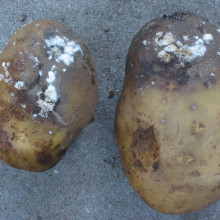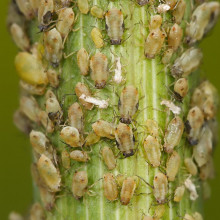In the NewsFlash this week - the relationship between infections and prostate cancer, genetic secrets of plant pathogens, finding lost memories and how drugs re-wire the brain.
In this episode

Genomic secrets of Potato Blight
The genome of the water mould responsible for Potato blight, and resultantly the great Irish famine, Phytophthora infestans, has been published in this week's Nature and there are some tantalising targets for attack.
 When we talk about the potato famine, which famously hit Ireland between 1845 and 1852, it seems like an historical, rather than contemporary concern. But plant diseases like potato blight remain a threat to food security worldwide - current annual losses due to blight are an estimated $6.7 billion.
When we talk about the potato famine, which famously hit Ireland between 1845 and 1852, it seems like an historical, rather than contemporary concern. But plant diseases like potato blight remain a threat to food security worldwide - current annual losses due to blight are an estimated $6.7 billion.
Preventing and treating blight has proven particularly difficult because it seems to adapt remarkably quickly to control methods, quickly taking hold in cultivars of potato that are, or rather were, genetically resistant to blight. Now, with the publication of its genome, we can start to understand just how it adapts so quickly, and devise better ways to fight it.
Chad Nusbaum, from the Broad Institute of MIT and Harvard, Cambridge, Massachusetts and colleagues from all over the world analysed the genome and compared it to other species of Phytopthora. They found a dense region of highly conserved genes, ones that the different species share, but the majority of the genome consisted of repeating regions.
This repetitive region of the genome was seen to contain genes that alter the normal biological processes in the plant, helping the blight to get past the plants defences. It also contained bits of DNA known to move around the genome, known as transposons, and this ability to alter the genome quite dramatically is thought to be a key feature in the rapid adaptability of the disease. Now that we know how it's doing it - we can start to identify targets for attack.
 In a related paper in Current Biology this week, Dawn Arnold, from the university of the West of England, or UWE, reports on how the defences of the bean plant may be driving bacteria to become more pathogenic.Working with teams from Imperial College London & Reading University, the UWE researchers looked at Pseudamonas syringae, the bacteria that causes halo blight in bean plants. They observed that the bacterium, in response to the bean plant's defences, ejects a region of their DNA, or a Genomic Island, which is then taken up by other bacteria. This allows for horizontal gene transfer, which is thought to play a key role in the evolution of bacteria.
In a related paper in Current Biology this week, Dawn Arnold, from the university of the West of England, or UWE, reports on how the defences of the bean plant may be driving bacteria to become more pathogenic.Working with teams from Imperial College London & Reading University, the UWE researchers looked at Pseudamonas syringae, the bacteria that causes halo blight in bean plants. They observed that the bacterium, in response to the bean plant's defences, ejects a region of their DNA, or a Genomic Island, which is then taken up by other bacteria. This allows for horizontal gene transfer, which is thought to play a key role in the evolution of bacteria.
We know that bacteria can swap sections of their genome, and swapping of the pathogenic genomic island has been seen working in a few different ways in some pretty nasty characters - yersinia, which causes plague; the food poisoning bacteria salmonella and Vibrio cholerae, responsible for cholera. However, this is the first time that it's been seen to happen within a host, and seems to be encouraged by the stress of host immune attack.
Looking at the rest of the genome, they were able to identify genes that were essential to allow this gene transfer to occur. We may now be able to target these genes to help slow the development of pathogenicity and resistance in a range of bacteria, and make our disease control systems much longer lasting.

It's in there somewhere...
It has happened to us all at some point - a person looks familiar but you can't remember where on earth you met them. Now new research by neuroscientists in the states published in this week's edition of the journal Neuron suggests why - the memory does exist, but you just can't retrieve it.
Using functional MRI scanning, the scientists found that brain activity while remembering an event is very similar to when you first experienced it, even if you can't remember the details. But the researchers, led by Jeff Johnson, think that we could manage to access this missing details. So it could help us to boost our memory-power as we get older, and also help to shed light on vivid - but traumatic- memories that we may subconsciously forget.
 Inside a brain scanner, volunteers were shown words and asked to do various tasks. For example, this included imagining how an artist would draw the object named by the word, thinking about how the object is used, or pronouncing the word backward in their minds.
Inside a brain scanner, volunteers were shown words and asked to do various tasks. For example, this included imagining how an artist would draw the object named by the word, thinking about how the object is used, or pronouncing the word backward in their minds.
Then twenty minutes later, the volunteers saw the words a second time, and were told to remember anything linked to them.
By comparing the initial patterns of brain activity with the later patterns, the researchers were able to link certain patterns of brain activity to the different activities. When a volunteer strongly recalled a word from a particular task, the pattern was very similar to the one generated during the task. Also, when they only weakly recalled what they'd thought of, they still produced a pattern recognisable as belonging to that particular task.
So the results suggest our memory is in there somewhere - we just need to work out how to get it out!

Addicted to Memories
Addictive drugs hijack a brain reward mechanism to strengthen drug-related memories and perpetuate drug use, according to a paper published in Neuron this week.
 It's already known that dopamine, the brain's feel-good reward chemical, plays a role in addiction, and also participates in a process called synaptic potentiation - the strengthening of nerve connections that happens during learning.
It's already known that dopamine, the brain's feel-good reward chemical, plays a role in addiction, and also participates in a process called synaptic potentiation - the strengthening of nerve connections that happens during learning.
To find out if dopamine would encourage synaptic potentiation as a result of exposure to drugs, John Dani from the Baylor College of Medicine in Houston, Texas, and colleagues gave physiologically significant doses of nicotine to freely moving mice while recording brain activity.
They noticed increased synaptic potentiation that correlated with the mice learning to prefer a location that was associated with the nicotine dose. They also recorded a local dopamine signal in the hippocampus, a region towards the centre of the brain that is critical for the formation of new memories, reinforcing the view that dopamine enables memories of specific events to be formed.
This starts a vicious cycle, where dopamine strengthens drug associated memories and thus attaches more importance to them, and increases the likelihood of future drug use. In any normal situation, this dopamine signal would mark memories and feelings about the environment as important, and this would mark an important part of the learning process, but in the presence of an addictive substance, the system is subverted.
John Dani summarised the importance of this for understanding addiction:"When specific environmental events occur, such as the place or people associated with drug use, they are capable of cuing drug-associated memories or feelings that motivate continued drug use or relapse." Understanding how drugs change our perception may help to develop treatments or means to prevent relapse, saving both money and lives.

14:50 - Aphids and Pesticides
Aphids and Pesticides
Professor Lin Field & Professor Kim Hammond-Kosak, Rothamsted Research
Ben - Also in the news this week - an international consortium of Aphid researchers have been studying the newly decoded aphid genome, due to be published later this year, with a view to developing better pesticides that will not let the aphids develop resistance. Diana O'Carroll met Professor Lin Field and Professor Kim Hammond-Kosak at the British Science Festival to find out why the aphid, and pesticide resistance, is such a problem...
 Lin - The problem is that we need to control insect pests so, insects are pests of many of our crops and if we didn't control them, we would have a severe reduction in crop production, and at the moment when all the emphasis is on trying to grow more food, we need to make sure we can control pests effectively. The trouble is that when you control pests with chemistry for instance, the pests are kind of one jump ahead of you at some point and they develop a resistance to those chemicals and we have to find ways of either overcoming that resistance or managing it or designing better pesticides that will overcome resistance and also be more selective for pest insects rather than beneficial insects.
Lin - The problem is that we need to control insect pests so, insects are pests of many of our crops and if we didn't control them, we would have a severe reduction in crop production, and at the moment when all the emphasis is on trying to grow more food, we need to make sure we can control pests effectively. The trouble is that when you control pests with chemistry for instance, the pests are kind of one jump ahead of you at some point and they develop a resistance to those chemicals and we have to find ways of either overcoming that resistance or managing it or designing better pesticides that will overcome resistance and also be more selective for pest insects rather than beneficial insects.
Diana - Lin, we've got some species of some little aphids there, I think. Could you quickly give us a talk through them?
Lin - Yes, I can. Aphids are a very important crop pest mainly, because they carry various diseases- plant viruses. They can do some direct damage by feeding on young shoots but the most damage is done by vectoring viruses. And one of the most important pests is this aphid, the 'peach potato aphid' or Myzus persicae, to give its Latin name. This is a very important pest in the UK of potatoes, sugar beet, oilseed rape and we have quite a lot of problems with this aphid because it's developed a resistance to many chemicals. This other aphid here is actually the pea aphid or Acyrthosiphon pisum. And the reason I've brought that along is not because it's a very important pest but because this is the aphid where we now have a genome sequence. So we have a full genome sequence for this aphid and most of the genes in there seem to be very similar to genes in other aphids, and we are now able to use that information to look at the genes and the proteins involved in insecticide binding and try to devise ideas about making better chemicals to overcome resistance or perhaps to bind to the target protein in this aphid rather than in a beneficial like a bee. So, having the genome of this aphid is now helping us with new control measures for other aphids.
Diana - And Kim, just to come to you, could you explain a little bit more about how sequencing the genome can help us find those targets?
Kim - Yes, I mean, when you sequence a genome, first of all, you end up with just a long string of A's, C's, T's and G's. But it's when you actually look at that in the context of the genes and where the genes are situated in the genome then some patterns start to emerge-what genes are present, what are absent, which ones are different between the species, and then you can actually say to yourself, does this actually then affect the biology of the organism? Because our different pests and pathogens have different strategies to attack and cause disease and damage to plants, and then you can start to say that there might be some correlations between the presence of particular genes and the way in which they actually have the strategy of attack.
 Diana - Do you think that finding these targets will be the solution?
Diana - Do you think that finding these targets will be the solution?
Kim - I don't think there'll ever be a final solution. It means that you're almost on a staircase and what you do is, you successfully hop up each step and then it gives you a chance of actually controlling what is going on at the moment, learn from the mistakes, benefit from the gains, and then hopefully move to the next step when you've got more information and by sequencing, particularly in the failures, the strains that come through, what is selected each time and then learning from those.
Lin - And, I think for insects, the benefit of having genomes from a whole different range of different insect species which we're now beginning to get, it's going to allow us to look at the use of chemicals that will target one species because one of the problems with using insecticide has been that the use of it in crop pests has spilled over into damage to non-target pest, which is what we want to avoid.
Ben - That was Kim Hammond-Kosak and Lin Field from Rothamsted Research explaining how understanding the genome of an insect pest can help to develop new control methods that get around the problem of pesticide resistance.










Comments
Add a comment